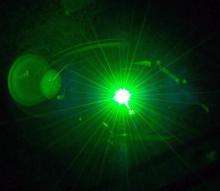February 4, 2016 report
Superfast light pulses able to measure response time of electrons to light

(Phys.org)—A team of researchers with members from Germany, the U.S. and Russia has found a way to measure the time it takes for an electron in an atom to respond to a pulse of light. In their paper published in the journal Nature, the team describes their use of a light field synthesizer to create pulses of light so fast that they were able to reveal the time it took for electrons in an atom to respond when struck. Kyung Taec Kim with the Gwangju Institute of Science offers a News & Views piece on the work done by the team in the same journal issue, outlining their work and noting one issue that still needs to be addressed with such work.
As scientists have begun preparing for the day when photons will replace electrons in high speed computers, work is being done to better understand the link between the two. One important aspect of this is learning what happens when photons strike electrons that remain in their atom (rather than being knocked out of them), specifically, how long does it take them to respond.
To find this answer, the researchers used what has come to be known as a light-field synthesizer—it is a device that is able to produce pulses of light that are just half of a single wavelength long—something many had thought was impossible not too long ago. The pulses are of such short duration that they only last for the time it takes to travel that half wavelength, which in this case, was approximately 380 attoseconds.
The light-field synthesizer works by combining several pulses of light brought together but slightly out of phase, allowing for canceling and ultimately, a single very short pulse. In their experiments, the researchers fired their super-short pulses at krypton atoms held inside of a vacuum. In so doing, they found that it took the electrons 115 attoseconds to respond—the first such measurement of the response time of an electron to a visible light pulse.
The team plans to continue their work by looking at how electrons behave in other materials, and as Kim notes, finding a way to characterize both the amplitude and phase of radiation from atoms driven by a light field.
More information: M. Th. Hassan et al. Optical attosecond pulses and tracking the nonlinear response of bound electrons, Nature (2016). DOI: 10.1038/nature16528
Abstract
The time it takes a bound electron to respond to the electromagnetic force of light sets a fundamental speed limit on the dynamic control of matter and electromagnetic signal processing. Time-integrated measurements of the nonlinear refractive index of matter indicate that the nonlinear response of bound electrons to optical fields is not instantaneous; however, a complete spectral characterization of the nonlinear susceptibility tensors—which is essential to deduce the temporal response of a medium to arbitrary driving forces using spectral measurements—has not yet been achieved. With the establishment of attosecond chronoscopy, the impulsive response of positive-energy electrons to electromagnetic fields has been explored through ionization of atoms and solids by an extreme-ultraviolet attosecond pulse or by strong near-infrared fields. However, none of the attosecond studies carried out so far have provided direct access to the nonlinear response of bound electrons. Here we demonstrate that intense optical attosecond pulses synthesized in the visible and nearby spectral ranges allow sub-femtosecond control and metrology of bound-electron dynamics. Vacuum ultraviolet spectra emanating from krypton atoms, exposed to intense waveform-controlled optical attosecond pulses, reveal a finite nonlinear response time of bound electrons of up to 115 attoseconds, which is sensitive to and controllable by the super-octave optical field. Our study could enable new spectroscopies of bound electrons in atomic, molecular or lattice potentials of solids, as well as light-based electronics operating on sub-femtosecond timescales and at petahertz rates.
Journal information: Nature
© 2016 Phys.org




















